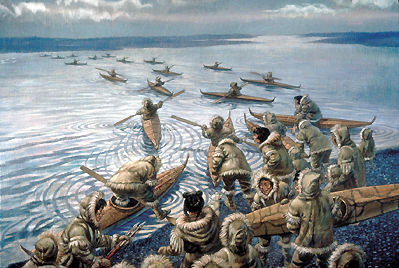Rigolet, NL, incorporated as a town in 1977, population 305 (2016 census), 306 (2011 census). Rigolet is a remote Inuit community located near the entrance of the Hamilton Inlet on the north coast of Labrador. It is the most southerly Inuit community in the world. Rigolet is also home of the self-proclaimed longest boardwalk in North America. The word rigolet means “channel” in French, describing the town’s location. The town is called Tikigâksuagusik in Inuttitut, the Inuktitut dialect spoken in Labrador.
Early History
Rigolet lies within the traditional territory of the Labradormiut (Labrador Inuit). The Labradormiut are descendants of the Thule people (see also Thule culture) who occupied most of the Atlantic coast of Northern Labrador. The Labradormiut moved into Hamilton Inlet in approximately 1600 CE. As hunter-gatherers, they lived near the sea in the summer and moved inland during the winter. Today, Rigolet is one of five communities that are part of Nunatsiavut, a self-governing territory located in the northern part of the Labrador Peninsula.

European Settlement
Numerous European groups have passed through Labrador for centuries. It is believed that the Vikings visited Labrador in approximately 1000 CE and referred to the area as Markland. Basque whalers came to the coast in the 16th century, followed by English and French fishermen and traders around the same time. During the 18th and 19th centuries, Rigolet was a stop for Europeans who travelled to the West to fish and hunt seals.
In 1836, the Hudson’s Bay Company (HBC) built a post in Rigolet that became the company headquarters in Labrador. European immigrants joined an established Inuit community in Rigolet, and a seasonal economy emerged revolving around the procurement of salmon and other natural goods.

There were once 25 HBC buildings in Rigolet that housed supplies for fur-trading posts. Today, four remain. The Net Loft Building, erected in 1876, is one of the last HBC structures standing in the province. The red and white building stored nets once used in the salmon fishery. Today, it functions as a museum.
The Lord Strathcona House is a replica of the former home of Donald Smith, a prominent figure in British public affairs who worked for a time for the HBC in Rigolet. Smith, later known as Lord Strathcona, is most famous for driving in the last spike of the Canadian Pacific Railway, at the other side of the country, in 1885. Once known as "the grandest house in all of Labrador," today the home operates as a cultural interpretation centre.

The Seashore Boardwalk
In the late 1800s, a wooden boardwalk was built to connect the HBC buildings in the community. After the HBC left in 1989, the town devised a plan to extend the boardwalk. They hoped to create an interpretative trail along the coast, to boost tourism. As the trail approached the length of the longest boardwalk in North America, the town decided to try and surpass this record.
Extending the boardwalk took 16 years, with work beginning in 1999 and ending in 2015. Today, visitors can view whales and other wildlife from the boardwalk, while also taking in historic sites. One such site was an area where hundreds of soldiers were stationed during the Second World War. The boardwalk also passes by Burnt Wood Cove, which marks the site of an old salmon factory. The trail ends at Double Mer Point, an archaeologically significant site with ruins of a late 18th-century Inuit winter village. An Ottoman pipe and European cups and bowls were discovered here.

Upon completion, Rigolet was in the national news for attempting to build the longest boardwalk in North America. Rigolet’s boardwalk measures 9 km, some 2.5 km longer than Atlantic City’s 6.4 km boardwalk. Currently, Guinness World Records does not have an entry for the longest boardwalk in the world, although the longest wooden walkway is located in Dalian, China, at 20.99 km.

 Share on Facebook
Share on Facebook Share on X
Share on X Share by Email
Share by Email Share on Google Classroom
Share on Google Classroom



